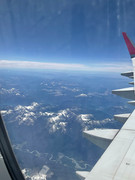Dispatch: Antarctica
- donnaramadishes
- Sep 5
- 5 min read

The White Continent, Antarctica, is about as remote and pristine a place tourists can visit as any. For those who are drawn to icebergs, penguins, cruising, arctic fauna in general, and are willing to pay (dearly) to see them, this is a trip which should be at the very top of your travel bucket list. I am a fairly well-traveled person who, until this trip (in 2022), could not say what my favorite trip/ destination was; I now have a quick reply: Antarctica. (Hard stop.)
Is a voyage to Antarctica right for you? Below I address the key questions potential travelers may have about visiting, to help you answer that question: How (to visit), Why (to visit), What (to do when visiting), When (to visit), and Who (should visit).
How does one visit Antarctica?
The vast majority of tourism to Antarctica is by cruising. There are quite a number of quality operators (basic expedition to luxury expedition), with most voyages departing from the southern-most reaches of South America. If cruising is something you want to minimize, and you can find the funds, Silversea now offers fly-cruises to the continent where you only cruise the typically calm Antarctic waters, avoiding the 2-3 day crossings from South America in both directions.
In order to get to Antarctica by ship, one must first cross the Drake Passage. This is where the Pacific, Atlantic and Southern oceans converge, and with high winds and a lack of landmasses to create resistance, the crossing can be harrowing (aka "the Drake Shake"). The crossing is affectionately called "the Drake Lake" if swells, wind, and weather are calm. I had the Lake in one direction and a little bit of the Shake in the other -- nothing motion sickness medication didn't take care of, though.
Why visit Antarctica?
Well, aside from the bragging rights (and its own passport stamp!), visiting Antarctica allows you to see up-close (!) a plenitude of cold-climate animals and ice bergs/ ice floes. Most operators in Antarctica have naturalists and other relevant experts on board so that you learn about the geology, zoology, and Antarctic expedition history. Aside from those of us drawn to penguins, if you are a birder or whale-watcher, a trip to Antarctica will fulfill many of your sighting goals.
With climate change impacting the ice sheets and glaciers in Antarctica, there is talk of fully suspending the already-limited tourism at some point in the foreseeable future, so best to go while you can.
What do you do there?
Once you have crossed the Drake Passage, most days consist of off-ship excursions to explore this remote part of the world. Some of these are simply zodiac rides which get you up-close to the animals, ice, and land formations, while others are zodiac rides to get you ashore. (Zodiacs are rigid inflatable boats with solid hulls and inflatable pontoons which you step into from a door on your ship). Once ashore, you can explore penguin rookeries, see evidence of failed early expeditions, or trek around and take in the other-wordly land/sea/snow-scapes.
If you so desire, there are cruise operators which offer nordic skiing on the glaciers and kayaking among the icebergs; both experiences being truly remarkable.
Of course, if you don't want to leave the ship, the views on-board are impressive (especially if you splurge for a balcony/ verandah cabin, which some ships have).
When to visit
There is most definitely a tourist season for Antarctica -- typically late October through late March (the warmer, less icy months). Opportunities for nordic skiing are most likely to occur at the beginning of the season, while there is still decent snowpack. November and December offer penguin courtship and large icebergs, while January and February bring the warmest temperatures and the most accessible wildlife, including the newly hatched penguin chicks. March offers significantly lower prices, impressive whale sightings as they play, and more curious penguin chicks. I went in early January, had mostly moderate temperatures (30s-40s F) and saw lots of penguin chicks, which are every bit as adorable as you imagine they are. That said, our last day brought with it snow and sea ice, which prompted a quick departure from that area.
Who should visit
I'll be frank -- this journey is not for everyone: it is very expensive (we saved for years!), can be very cold, typically requires crossing the Drake Passage (one of the roughest seas around) and requires a comfort with cruising. While you don't NEED to participate in off-boat excursions/zodiac rides, they greatly enhance the experience; so if you are unsteady on your feet or have trouble walking on uneven ground or snow, maybe this journey is not for you. I'd add that if you don't like penguins, you should skip the trip, but is there anyone who doesn't like penguins??? I seriously defy anyone to be near penguins and not smile/ have their mood lifted significantly!
A couple of other things
If it isn't obvious, I had the time of my life when I visited Antarctica, and I would love to return. I traveled with Silversea Expeditions because I figured if I was going to be seasick enough crossing the Drake Passage that I didn't want to leave my cabin, I could have my butler get me something to eat or drink; PLUS, they had cabins with balconies and kayaks on board (a dream of mine had been to kayak among ice bergs). The other company I seriously considered was Lindblad/ National Georgraphic, who I have traveled with on other journeys, and love.
In terms of gear, you may have noticed that tourists wear red parkas, which are provided to you as part of the cruise cost. I assume this is because the red stands out and makes you easy to find should you wander off... You will also want waterproof pants, high rubber boots, and poles (all of which you can rent from some operators), as well as typical winter weather gear -- layers, hats, gloves, etc. Binoculars and cameras are a must as there is so much that you'll want to capture in your mind or as an image. My phone was excellent, although some of the pictures included in this blog post were taken by my cousin, who had a big camera (and knew how to use it).
Additionally, this is a voyage often booked years in advance, and I'd strongly recommend getting trip insurance for it. The peace of mind goes a long way and you do not want anything causing you anxiety on a once-in-a-life trip like this.
Bon voyage!





























































Comments